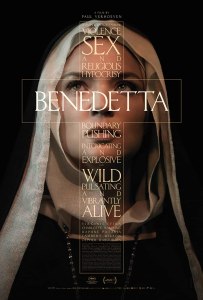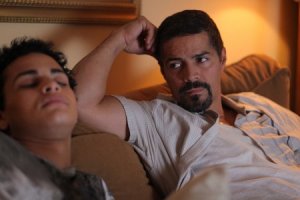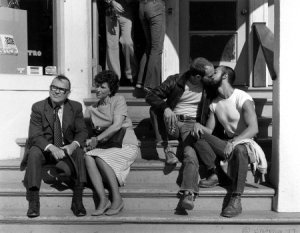Daniel Garber talks with Daniel Stamm and Jacqueline Byers about Prey for the Devil
 Hi, this is Daniel Garber at the Movies for culturalmining.com and CIUT 89.5 FM.
Hi, this is Daniel Garber at the Movies for culturalmining.com and CIUT 89.5 FM.
Sister Ann is a nun who works as a nurse in a Catholic hospital. It’s a training hospital, with classes held with in its walls. There are doctors and psychiatrists there to observe and treat the patients. But there is something unique about this medical centre: the patients are possessed and treatment involves an exorcism. Ann believes she has special experience dealing with possession dating back to her childhood. And she wants to  train alongside the priests — but that is not allowed. And when she attempts to help a little girl named Natalie, she is chastised by the church for putting herself and the patient in danger. Can she help cure little Natalie? Or will she end up as Prey for the Devil.
train alongside the priests — but that is not allowed. And when she attempts to help a little girl named Natalie, she is chastised by the church for putting herself and the patient in danger. Can she help cure little Natalie? Or will she end up as Prey for the Devil.
Prey for the Devil is a new horror film about possession, exorcism, the supernatural and the Catholic Church. It harkens back to classic films like the Exorcist, but this time from a woman’s point of view. The film is directed by Daniel Stamm, an award-winning German-born filmmaker and documentarian. The film stars Jacqueline Byers an accomplished actress who you may have seen at the Toronto Fringe festival, in movies and in the hit sci-fi series Salvation.
I spoke to Daniel Stamm and Jacqueline Byers in person, on site, in Toronto.
Prey for the Devil had its world premiere at Toronto After Dark on March 19th, and opens in theatres on March 28th.
Organized religion. Films reviewed: Hand of God, Agnes, Benedetta
Hi, this is Daniel Garber at the Movies for culturalmining.com and CIUT 89.5 FM.
It’s December and we’re entering holiday season, so I thought it’s time to talk about movies involving religion. So this week I’m looking at three new movies with (small c) catholic themes. There’s an adolescent boy in 1980s Naples who witnesses the “Hand of God”, a lesbian nun in renaissance Tuscany who is in love with God, and another nun in the US who may be possessed by the Devil.
Co-Wri/Dir: Paul Verhoeven
It’s the 1600s in Tuscany Italy. Benedetta (Virginie Efira) is a beautiful young nun with blond hair and a quick wit. She was placed in small town convent as a young girl, paid for by a rich dowry her parents gave the Abbess (Charlotte Rampling). Now Benedetta is married to God, both metaphorically, and literally, in her mind. She goes through vivid spells, where she has sex with a violent Jesus after he slays all her attackers with a sword. She also has a streak of cruelty since she was told that suffering, by oneself and others, brings one closer to God. The cynical Abbess thinks Benedetta’s trances are just an elaborate hoax. But everything changes when Bartolomea (Daphné Patakia) a gorgeous young novice, appears at their doorstep.
She is illiterate, and the victim of horrific abuses from her father and brothers. Benedetta takes her under her wing, nurtures her and schools her in divinity, reading and math. In exchange, Bartolomea sleeps with her, awakening hidden desires. Could this be love? Benadetta says she’s having chaste, spiritual sex  with Jesus himself, not carnal passion with the young novice. And her spontaneous stigmata — bleeding that appears in her hands and feet like Jesus on the cross — attracts pilgrims and followers from far and wide seeking advice and cures. But when she’s caught using a wooden statue of the Virgin Mary as a sex toy, things take a turn for the worse. A cruel Nuncio (Lambert Wilson) arrives from plague-ridden Florence for an inquisition. Will he manage to wring a confession from the two women? Or will Benedetta’s spiritual powers protect her from being burned at the stake?
with Jesus himself, not carnal passion with the young novice. And her spontaneous stigmata — bleeding that appears in her hands and feet like Jesus on the cross — attracts pilgrims and followers from far and wide seeking advice and cures. But when she’s caught using a wooden statue of the Virgin Mary as a sex toy, things take a turn for the worse. A cruel Nuncio (Lambert Wilson) arrives from plague-ridden Florence for an inquisition. Will he manage to wring a confession from the two women? Or will Benedetta’s spiritual powers protect her from being burned at the stake?
 Benedetta (based on actual historical records) is a bittersweet and passionate look at the life and love of a lesbian nun in Northern Italy. It’s sexually explicit with lots of matter-of-fact nudity throughout the film as well as some horrific violence (remember, this is a movie by the great Paul Verhoeven who knows well how to keep bums in seats). This is a visually stunning film, with sumptuous views of sunlit cathedrals, long-flowing costumes, diaphanous bed curtains and beautiful faces and bodies. Never has a convent looked so erotic. But it’s also a fascinating look at faith in the face of cynical religious practices. Benedetta is a beautiful and shocking film.
Benedetta (based on actual historical records) is a bittersweet and passionate look at the life and love of a lesbian nun in Northern Italy. It’s sexually explicit with lots of matter-of-fact nudity throughout the film as well as some horrific violence (remember, this is a movie by the great Paul Verhoeven who knows well how to keep bums in seats). This is a visually stunning film, with sumptuous views of sunlit cathedrals, long-flowing costumes, diaphanous bed curtains and beautiful faces and bodies. Never has a convent looked so erotic. But it’s also a fascinating look at faith in the face of cynical religious practices. Benedetta is a beautiful and shocking film.
Wri/Dir: Mickey Reece
Sister Agnes (Hayley McFarland) is a young nun in a convent whose birthday celebration turns into a disaster. Now he’s tied to her bed, foaming at the mouth and speaking in strange otherworldly voices. What is going on?Enter Father Donoghue (Ben Hall). He’s a grizzled priest with a shady past, but also many successful exorcisms under his belt. And he takes a newby with him, the devout Benjamin (Jake Horowitz) a divinity student who has yet to take his vows. Father Donoghue doesn’t believe that they’re actually possessed, just that they think they are. And only the elaborate song and dance of an exorcism will allow them to give it up. At the convent, Mother Superior (Mary Buss) a stickler for rules, is much less enthusiastic. She’s not comfortable with men under her roof,  especially a young one without a priest’s collar. But she allows it to proceed. And the routine exorcism takes an unexpected turn.
especially a young one without a priest’s collar. But she allows it to proceed. And the routine exorcism takes an unexpected turn.
The story picks up with Sister Agnes’s friend Sister Mary (Molly C. Quinn). She left the convent after the incident. Now she works at two jobs — a convenience store and a laundromat, —and is trying to live a normal life. But she doesn’t know what to do or how to act. Can she keep the faith? Matters aren’t helped when she meets a cynical stand up comic at a local dive bar (Sean Gunn). Can he teach her what she needs to know?
 Agnes is a look at faith, and self-doubt within the church. It starts as a genre pic, a conventional, low-budget horror, but it ends up as a deeper and darker melodrama propelled by scary undertones. It’s called Agnes, but it’s actually in two acts, the second part mainly about Sister Mary. It’s unpredictable and uncomfortable, and sometimes a bit bloody. This may be the first Mickey Reece film I’ve ever watched but I can see why this indie filmmaker has such an avid following. The film has an interesting mix of experimental film and conventional, even kitschy, horror, comparable to avant-garde filmmakers like Ben Wheatley and Peter Strickland. Not for everyone, but I enjoyed it — and I think want to see more Mickey Reece.
Agnes is a look at faith, and self-doubt within the church. It starts as a genre pic, a conventional, low-budget horror, but it ends up as a deeper and darker melodrama propelled by scary undertones. It’s called Agnes, but it’s actually in two acts, the second part mainly about Sister Mary. It’s unpredictable and uncomfortable, and sometimes a bit bloody. This may be the first Mickey Reece film I’ve ever watched but I can see why this indie filmmaker has such an avid following. The film has an interesting mix of experimental film and conventional, even kitschy, horror, comparable to avant-garde filmmakers like Ben Wheatley and Peter Strickland. Not for everyone, but I enjoyed it — and I think want to see more Mickey Reece.
Dir: Paolo Sorrentino
It’s 1984. Fabietto (Filippo Scotti) is a young man at Don Bosco high school in Naples, Italy. He is precocious and well-read, — constantly quoting classic verse — but has neither friends nor sexual experience. He gets most of his advice from his big brother (who shares a room with him) and his parents. Dad (Toni Servillo) is a self-declared communist while his mom (Teresa Saponangelo) is a inveterate practical joker. Then there are all the odd-ball neighbours in their apartment building (including a former countess) and his even stranger family members. But foremost in Fabio’s eyes is his aunt Patrizia (Luisa Ranieri). She suffers from delusions which cause her to innocently expose her flawless naked body at unusual times — which provide fodder  for the sexually-starved Fabio’s fantasies.
for the sexually-starved Fabio’s fantasies.
It’s also the year when rumour has it that international soccer star Maradona may start playing for the local team — an obsession of most of his family. Third on Fabietto’s list — after sex and football — are the movies. Fellini is casting extras in Napoli — he goes to the audition — while another up-and-coming director is shooting his latest film downtown. That director is also dating the very actress Fabio is dying to meet. Will he ever fulfill any of his wishes? And how will this pivotal year affect the rest of his life?
Hand of God (the title refers to a legendary goal scored by Maradona) is a coming-of-age story based on the filmmaker’s  own recollections. It seems like the straight version of the popular Call Me By Your Name, another Italian feature. Set in the 80s, it’s also about a precocious adolescent’s first sexual experiences, situated within a quirky but loving family. There’s lots of 80s music, fashion and hairstyles to look at. Filippo Scotti also happens to looks a hell of a lot like Timothée Chalamet. That said, it is its own film, and fits very firmly within Sorentino’s work, including his fascination with celebrities as characters,
own recollections. It seems like the straight version of the popular Call Me By Your Name, another Italian feature. Set in the 80s, it’s also about a precocious adolescent’s first sexual experiences, situated within a quirky but loving family. There’s lots of 80s music, fashion and hairstyles to look at. Filippo Scotti also happens to looks a hell of a lot like Timothée Chalamet. That said, it is its own film, and fits very firmly within Sorentino’s work, including his fascination with celebrities as characters,
perennial actors like the great Toni Servillo hapless men, as well as the requisite “naked woman with perfect breasts” who manages to turn up, in one form or another, in all his movies. Although Hand of God isn’t that original, and a bit contrived, it does have some very funny and a few honestly shocking scenes that should not be missed. I liked this one.
Hand of God and Benedetta both open theatrically in Toronto this weekend at the TIFF Bell Lightbox; check your local listings; and Agnes starts next Friday at the Carlton Cinema in Toronto.
This is Daniel Garber at the Movies, each Saturday morning, on CIUT 89.5 FM and on my website, culturalmining.com
Eastern Europe at TIFF13. Films reviewed: The Burning Bush, Ida, Le Grand Cahier
Hi, this is Daniel Garber at the Movies for culturalmining.com and CIUT 89.5 FM, looking at high-brow and low-brow movies, indie, cult, foreign, festival, documentary, genre and mainstream films, helping you see movies with good taste, movies that taste good, and how to tell the difference.
Eastern Europe used to have a specific meaning — not so much geographical as political. It meant the countries  behind the iron curtain. Western Europe was allied with the US, Eastern Europe with the Soviet Union. And it meant the barrier to those scary “Asiatic” hordes waiting to swarm, en masse, across Western Europe to enslave us all.
behind the iron curtain. Western Europe was allied with the US, Eastern Europe with the Soviet Union. And it meant the barrier to those scary “Asiatic” hordes waiting to swarm, en masse, across Western Europe to enslave us all.
Now, though, there is no eastern Europe anymore. Just Europe. Maybe mittel-Europe if you want to be fancy about it. But the old Eastern Europe lives on in the minds and films of the countries that suffered the brunt of two World Wars, and both Nazi and Stalinist occupations.
So, this week I’m looking at some really good movies, all from Eastern Europe, all from TIFF. They come from the Czech Republic, Poland and Hungary: all historical dramas, two set in the 1960s and one in 1944.
Dir: Agnieszka Holland
In January, 1969, Jan Palach – a history student at Prague’s Charles University – walks into Wenceslaus square with a bucket. He pours the liquid all over himself then sets himself on fire. He’s rushed to a hospital to treat his burns, but is barely alive. He immediately becomes a symbol of Czech opposition to the invasion of the country by Russian tanks to crush the short-lived Prague Spring.
The Party overlords want his story silenced, or the narrative stripped of any political significance. The Czech investigator looking into the case doesn’t want the Russians to impose martial law. His political allies at the university – students and some professors – want his story told. And his family – his older brother and his mother, the ticket seller at a remote train station – are devastated when they discover what happens.
But when a privileged party hack makes the papers when he states Jan Palach not only was working for the west, but never intended to burn himself alive. Jan’s steadfast mother decides to sue the man who made the speech, with the help of a sympathetic lawyer, a woman, and a young idealistic university student. But the wrath of the party is let loose all around the main characters, with midnight phone calls, men in black cars parked outside their homes, and mysterious disappearances.
The Burning Bush is an epic, four-hour-long story, (originally made as a Czech mini-series, in four, one-hour parts.) It has many diverse plot lines and dozens of characters. It alternates between the hope Jan Palach’s action inspired, and the dread of authoritarian rule that fought against him and his allies.
But it stands up beautifully all-together. The director, the renowned Agnieszka Holland (Europa Europa, Olivier Olivier, In Darkness) follows this gripping story all the way through. It had me glued to the screen.
Dir: Pawel Pawlikowski
Anna (Agata Trzebuchowska) was an orphaned baby in WWII Poland, left at a nunnery near Lodz. She wears a plain grey dress and covers her hair. She’s quiet and obedient. Now 16, she’s ready to take her vows, become a nun, but Mother Superior insists first she speak to her only known relative, her aunt Wanda Gruz (Agata Kulesza). But why?
Wanda is a woman of the world. She wears lipstick, smokes cigarettes and listens to jazz.
And she sleeps with younger men she picks up in bars. She’s cold, cynical and bitter. She used to be a high-ranked communist party prosecutor, though she seems to have lost her status. And she’s Jewish.
Anna discovers she is too, and her real name is Ida. Wanda advises her
Ida wants to see her parents’ grave. Wanda laughs: Jews who died in the war have no graves! But the two of them head out to the small town. The family that took over their home stonewalls them and says Jews never lived there. But does he know what happened to her parents? Never heard of them.
Wanda delves deeper. Ida starts to discover her own hidden history. Wanda warms toward her – Ida is just like her sister, with her red hair, and three dimples when she smiles. Ida dips her toe into the real world (jazz, alcohol, cigarettes, men). She has to decide between cosmopolitan urban Poland and a cloistered life behind the walls.
Ida is beautifully shot in black and white on a 4×3 frame (not widescreen) like old TV shows. Each scene stylized. It’s only 80 minutes long, but has everything it needs. It’s subtle, compact, minimalist. The two actresses – the two Agatas – as the naïve teen and her world-weary aunt are both fantastic, with fine rapport as their relationship gradually changes. This is a great movie – beautiful to look at, moving to watch.
 Le Grand Cahier (A Nagy Füzet)
Le Grand Cahier (A Nagy Füzet)
Dir: János Szász (based on the novel by Agota Kristov)
A soldier and his wife live in a big city (Budapest?) with their twin boys (András and László Gyémánt). Life is beautiful. Then suddenly, boom! it’s 1944, and the Germans are moving in, taking over Hungary. So they send the twins off to stay with the wife’s estranged mother in a remote farm, to keep them safe. It’s wartime, their dad says, everything’s different. He gives the a big black ledger – the Grand Cahier of the title – and they promise to record everything that happens.
Grandmother – fat, gruff, unmannered – is known as the witch by the locals. She has no friends, and takes care of the farm all by herself. “I’ll put them to work – they don’t eat for free.” The twins – dressed in navy peacoats and clean white shirts — are terrified by the evil witch. They have one book to read – the bible – but they use it for memorization and grammar skills not for prayers.
The boys decide in order to survive the war they have to be impervious to pain, hunger, and remorse. They refuse food from Grandmother, and take turns punching and hitting each other to see who can endure the most.
They start to meet people. There’s a girl they call harelip (Orsolya Tóth) — who teaches them how to steal. A kindly Jewish shoemaker gives them boots. Then there’s the corrupt deacon at the church and his lascivious secretary – she introduces them to the adult world but they recoil from her black heart. And a gay Nazi officer, fascinated when he sees the twins punching each other. The twins record it all, good and bad.
They witness the wartime atrocities and start to kill: first insects,  working their way up the food chain. Will they become killers themselves, just like the people around them? Or will they retain a sense of morality?
working their way up the food chain. Will they become killers themselves, just like the people around them? Or will they retain a sense of morality?
Le Grand Cahier is an amazing, rich, and disturbing coming-of-age story, told through the twins’ eyes. The two boys — undifferentiated, nameless — give a mythical, novelistic view of wartime life under the Nazi occupation. The movie follows them until the end of the war, in a gripping unexpected adventure. You should see this one when it comes out.
The Burning Bush, Ida, and Le Grand Cahier, all played at TIFF13 – keep an eye open for these three films. Also worth mentioning are two movies whose titles are self-explanatory. A documentary about a dissident theatrical troop that uses its performances to challenge the authoritarian Belarus government: Dangerous Acts Starring the Unstable Elements of Belarus (Madeleine Sackler); and a drama about an Australian woman who discovers the hotel in Serbian Bosnia she slept in was the site of unspeakable war crimes: For Those Who Can Tell no Tales, (Jasmila Zbanic, who previously directed the excellent Grbavica (2006).)
This is Daniel Garber at the Movies, each Friday morning on CIUT 89.5 FM and on my website,culturalmining.com
May 25, 2011. Inside Out Festival. Renee, Lost in the Crowd, Gun Hill Road, Black Field, Harvest, We Were Here
Hi, this is Daniel Garber at the Movies, for culturalmining.com and CIUT 89.5 FM.
 Toronto Inside-Out festival is one of the world’s biggest LGBT film festivals, that shows movies and documentaries from around the world by and about lesbians, gays, bisexuals, and transsexuals. Or queers for short. The festival is continuing through this weekend, mainly at Toronto’s Light Box, and I hear there are still some tickets available, so now’s your chance to catch some of these very varied and interesting movies.
Toronto Inside-Out festival is one of the world’s biggest LGBT film festivals, that shows movies and documentaries from around the world by and about lesbians, gays, bisexuals, and transsexuals. Or queers for short. The festival is continuing through this weekend, mainly at Toronto’s Light Box, and I hear there are still some tickets available, so now’s your chance to catch some of these very varied and interesting movies.
So this week I’m going to look at a cross-section of movies and docs at this festival with a special emphasis on some good movies about the too often neglected “T” in LGBT. Next week: more on the “L” word.
Dir: Eric Drath
“I’m getting the message across that you can be a transsexual… and yet be a nice, normal, socially acceptable and productive member of society.” – Renee Richards.
Renee Richards was born as Richard Raskin, who grew up as an aggressive alpha male, served in the navy, became a tennis champ, a young man with dating prowess, a surgeon, a husband and a father.
But in the early seventies, after years of agonizing, and (after first chickening out on her first attempt, when she went to Morocco for sex-reassignment surgery) she took the plunge and became a woman. She named herself Renee (French for reborn) and started a new life. She became a sensation on the women’s tennis circuit until the past came out. She was ostracized, alienated by many tennis players, and splashed across the mass media.
They attempted to force Renee Richards to take a DNA test to prove her sex – this despite surgery, hormones, her day-to-day identity, clothes, body, voice and name. So she took them to court.
This is a very good, sympathetic documentary, that uses TV sports footage, home movies, newspaper articles and present- day interviews with family members, and famous tennis players (like Billie Jean King and Martina Navritolova). The most emotionally trying part of the documentary is about her difficult relationship with her son Rick.
Dir: Susi Graf
…is another documentary, also touching on problems faced by transsexuals and others. But if Renee is about rich and famous celebrities, Lost in the Crowd is about the other side of things. It’s about Queer youth who migrate to new York City to escape homophobia and other dangers in their hometowns, only to find themselves penniless, homeless and alone on the streets of Manhattan. It shows a few of these kids and young adults, many latina, and gay or trans, who seek shelter but end up in prison, on the streets, or dead.
While a very important issue, I was a bit disappointed by the movie, since it mainly just showed the victimization of the runaways by drugs, prostitution, and crime. It didn’t really offer any new viewpoint on the standard risks that face all runaways. One exception were the scenes shot in a prison, where one person (who had been arrested for low-level drug dealing) said he felt more free in the jail than he had in his midwestern small town.
Much more moving was a fictionalized drama about many of the same issues, a movie called
Dir: Rasheed Ernesto Green
This tells about Enrique, and ex-con out on parole going back home. He’s an ultra-macho Puerto Rican-American who was known for attacking any “maricon” in prison who might have looked at him the wrong way. What’s a few months of solitary if he’s defending his own masculinity? He arrives back with his street corner pals to see his much missed son Michael (Harmony Santana). But something about Michael has changed.
He’s living his life as a girl in school, but like a boy at home. He hangs out with his friends at school but faces widespread bullying in the hallways. As pretty and strong Vanessa, she meets a boyfriend at a poetry slam, but he’s less friendly once he discovers Vanessa is a pre-op transsexual. He doesn’t want to see her as a boy – she has to cover up anything that might turn him off. But Michaels’s father doesn’t want to see his son as in any way feminine. He attacks him with a scissors and hacks off his long hair.
Gun Hill Road is a good, moving drama of the trials and tribulations of being trans in a public school, and how both a father and a son have to learn how to understand each other. The actor playing Vanessa/Michael is excellent, and you feel for all the characters. And it has a great latino hiphop soundtrack.
Black Field
Dir: Vardis Marinakis
In the middle ages, at its height, the Ottoman empire used a special unit in their military known as the Janissaries. This was a division consisting entirely of paid, trained soldiers who were also slaves. They had no outside friends or families because they were kidnapped as small boys from outlying villages in the Balkans. Eventually, they converted to Islam and enlisted in this all-male, elite part of the army — the Janissaries. In this movie, a wounded janissary (Hristos Passalis) is found outside a Christian convent in a remote, mountainous region of Greece. The black-hooded nuns take him in, chain him up, while they tend to his wounds. A young nun, Anthi is sent to heal him, but there she makes a surprising discovery — his genitals are like hers. She is actually a boy, who had been taken in as an infant and raised there, so that the Mother Superior could save him from being kidnapped and made into… a janissary!
height, the Ottoman empire used a special unit in their military known as the Janissaries. This was a division consisting entirely of paid, trained soldiers who were also slaves. They had no outside friends or families because they were kidnapped as small boys from outlying villages in the Balkans. Eventually, they converted to Islam and enlisted in this all-male, elite part of the army — the Janissaries. In this movie, a wounded janissary (Hristos Passalis) is found outside a Christian convent in a remote, mountainous region of Greece. The black-hooded nuns take him in, chain him up, while they tend to his wounds. A young nun, Anthi is sent to heal him, but there she makes a surprising discovery — his genitals are like hers. She is actually a boy, who had been taken in as an infant and raised there, so that the Mother Superior could save him from being kidnapped and made into… a janissary!
 The movie follows – literally follows, the camera holds back behind the two as they walk through the lush forest, a green-covered swamp, and a dark rocky area – the tough, mean, AWOL soldier and the timid, whispering nun, as he forces the newly discovered boy to reclaim his male identity, and eventually become his partner. To make matters even more ambiguous, the boy who was raised as a girl is played by a very good actress (Sofia Georgovassili). It’s a slow-paced, challenging, sometimes violent, and at other times sensuous and exquisitely beautiful, first film. Very interesting to watch and should be seen on the big screen.
The movie follows – literally follows, the camera holds back behind the two as they walk through the lush forest, a green-covered swamp, and a dark rocky area – the tough, mean, AWOL soldier and the timid, whispering nun, as he forces the newly discovered boy to reclaim his male identity, and eventually become his partner. To make matters even more ambiguous, the boy who was raised as a girl is played by a very good actress (Sofia Georgovassili). It’s a slow-paced, challenging, sometimes violent, and at other times sensuous and exquisitely beautiful, first film. Very interesting to watch and should be seen on the big screen.
Dir: Benjamin Cantu
Marco is a young man who lives and works at an internship program on what used to be an East German communal farm. He wears overalls and a T-Shirt as he sorts carrots, bales hay, and clips the ears off cattle, along with the other interns. But he’s resisting committing himself to a lifetime of farm work. He doesn’t want to write the exam he has to take, mainly because he can’t write well. And he’s a bit of a loner – he won’t go out drinking with the other trainees, and they tease him for it.
But he enters into a silent friendship with a newby, Jacob. Things start to heat up in an abandoned old car (a Trabant?) and they realize they have something in common when Jacob finds the keys and drives them both into Berlin for an evening.
Harvest is another one of these hyper-realistic films – made on real locations, usually with non-actors, without a complicated plots, and often without a written script. There aren’t that many lines in this movie, and the budding relationship between Marco and Jacob is never really talked about – it just happens. But you totally understand and identify with all the characters, and the farm footage is fantastic – I’d never actually seen an enormous carrot-sorting mill. Harvetst is a very good, understated, realistic drama.
Dir: David Weissman
This is a documentary about San Francisco from the late 70’s until the early nineties. That was the period when the city was transformed from a gay mecca into the epicentre of a worldwide epidemic. I’m speaking about AIDS and HIV, then called the gay plague for the sudden, massive death toll of that community.
This movie is heart-wrenchingly moving because of the way it was made. They found a handful of people who lived there at that time and were somehow involved in that disaster, to tell the story of themselves and their friends directly to the camera.
The movie shows the face of one speaker’s friend and then close-ups, ten days later. So happily galavanting at a Castro street party one day, and then, suddenly, the same man infected with Karposi Sarcoma (cancerous, but painless black spots on the skin) and then, a few days after that, just dropping dead.
No one knew what was going on or what to do about it. Panic set in. The movie shows the quick progression of events — the protests, the medical advances, the set-backs — all told through the eyes of real, sympathetic men and women.
This is a very important, living oral history, illustrated by ample newspaper clips, snapshots and still photos.
These movies and more are part of Inside-Out, continuing on this weekend: you can check times atinsideout.ca . Also opening is the terrific documentary Bobby Fischer against the World, and the Canadian low-budget spooky, post-apocalyptic horror thriller The Collapsed, both of which I reviewed last week, and Little White Lies, a very funny, if long, French social comedy about the secrets and conflicts of a group of friends who vacation together; I reviewed that last year.
This is Daniel Garber at the Movies for CIUT 89.5 FM, and on my web site, Cultural Mining dot com.











leave a comment